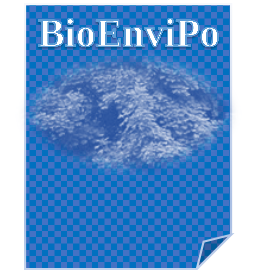Screening of Poly-β-hydroxybutyrate (PHB) Producing Bacteria and yeasts from locally vendored ‘Whey’ biowaste samples
DOI:
https://doi.org/10.31763/bioenvipo.v2i1.504Keywords:
Biowaste, Bacteria, PHB, Whey, YeastsAbstract
Whey- a byproduct of the manufacture of cheese has several commercial uses. The present study was undertaken to explore the microbial load of the whey and the possible existence of biopolymer (PHB) producing microorganisms in this byproduct. Whey samples collected from different vendors in the locality of Mirpur, Dhaka were brought into laboratory and the microbial load was determined by serial dilution technique using nutrient agar and YEPD medium. From 30 colonies, 32 strains were preliminarily isolated. Out of 32 isolates, fifteen exhibited pink fluorescence on mineral medium, indicating the presence of PHB production inside cells. Among these, seven strains were identified as members of the genera Candida tropicalis; based on molecular characterization. The remaining 8 isolates were bacteria. It is interesting to note that, yeast isolates were obtained from locally vendored samples whereas bacterial strains were predominant in commercial samples. This work can be considered as the first step in the development of an ecofriendly bio-refinery pathway for cheese industry.
References
Amaro, T., Rosa, D., Comi, G. & Iacumin, L. Prospects for the Use of Whey for Polyhydroxyalkanoate (PHA) Production. Front Microbiol 10, 992 (2019). https://doi.org:10.3389/fmicb.2019.00992
MacLeod, M., Arp, H. P. H., Tekman, M. B. & Jahnke, A. The global threat from plastic pollution. Science 373, 61-65 (2021). https://doi.org:10.1126/science.abg5433
Cedeño Palacios, C. A., Burgos Briones, G. A., Delgado Demera, M. H., Zambrano Murillo, X. S. & Vélez Martinez, C. V. Almidones de Cáscara de Yuca (Manihot Esculenta) y Papa (Solanum Tuberosum) para Producción de Bioplásticos: Propiedades Mecánicas y Efecto Gelatinizante. Revista Bases de la Ciencia. e-ISSN 2588-0764 6 (2021). https://doi.org:10.33936/rev_bas_de_la_ciencia.v6i2.3293
Sudesh, K., Abe, H. & Doi, Y. Synthesis, structure and properties of polyhydroxyalkanoates: biological polyesters. Progress in Polymer Science 25, 1503-1555 (2000). https://doi.org:10.1016/s0079-6700(00)00035-6
Marjadi, D. & Dharaiya, N. Screening and characterization of polyhydroxyalkanoates producing bacteria utilizing edible oil as carbon source. Journal of Environmental Research And Development 5, 764-772 (2011).
Davis, G. & Song, J. H. Biodegradable packaging based on raw materials from crops and their impact on waste management. Industrial Crops and Products 23, 147-161 (2006). https://doi.org:10.1016/j.indcrop.2005.05.004
in Bioplastics Magazine (2016).
Bioplastic&, E. & Institute, N. (2019).
Prazeres, A. R., Carvalho, F. & Rivas, J. Cheese whey management: a review. J Environ Manage 110, 48-68 (2012). https://doi.org:10.1016/j.jenvman.2012.05.018
Colombo, B., Pepe Sciarria, T., Reis, M., Scaglia, B. & Adani, F. Polyhydroxyalkanoates (PHAs) production from fermented cheese whey by using a mixed microbial culture. Bioresour Technol 218, 692-699 (2016). https://doi.org:10.1016/j.biortech.2016.07.024
Nikodinovic-Runic, J. et al. Carbon-rich wastes as feedstocks for biodegradable polymer (polyhydroxyalkanoate) production using bacteria. Adv Appl Microbiol 84, 139-200 (2013). https://doi.org:10.1016/B978-0-12-407673-0.00004-7
Berwig, K. H., Baldasso, C. & Dettmer, A. Production and characterization of poly(3-hydroxybutyrate) generated by Alcaligenes latus using lactose and whey after acid protein precipitation process. Bioresour Technol 218, 31-37 (2016). https://doi.org:10.1016/j.biortech.2016.06.067
Obruca, S., Marova, I., Melusova, S. & Mravcova, L. Production of polyhydroxyalkanoates from cheese whey employing Bacillus megaterium CCM 2037. Annals of Microbiology 61, 947-953 (2011). https://doi.org:10.1007/s13213-011-0218-5
Thammasittirong, A., Saechow, S. & Thammasittirong, S. N. Efficient polyhydroxybutyrate production from Bacillus juice substrate thuringiensis using sugarcane. Turk J Biol 41, 992-1002 (2017). https://doi.org:10.3906/biy-1704-13
Ramsay, B. A. et al. Production of poly-(beta-hydroxybutyric-co-beta-hydroxyvaleric) acids. Appl Environ Microbiol 56, 2093-2098 (1990). https://doi.org:10.1128/aem.56.7.2093-2098.1990
Spiekermann, P., Rehm, B. H., Kalscheuer, R., Baumeister, D. & Steinbuchel, A. A sensitive, viable-colony staining method using Nile red for direct screening of bacteria that accumulate polyhydroxyalkanoic acids and other lipid storage compounds. Arch Microbiol 171, 73-80 (1999). https://doi.org:10.1007/s002030050681
Miller, G. L. Use of Dinitrosalicylic Acid Reagent for Determination of Reducing Sugar. Analytical Chemistry 31, 426-428 (2002). https://doi.org:10.1021/ac60147a030
Law, J. H. & Slepecky, R. A. Assay of poly-beta-hydroxybutyric acid. J Bacteriol 82, 33-36 (1961). https://doi.org:10.1128/jb.82.1.33-36.1961
Manna, A., Banerjee, R. & Paul, A. K. Accumulation of poly (3-hydroxybutyric acid) by some soil Streptomyces. Curr Microbiol 39, 153-158 (1999). https://doi.org:10.1007/s002849900437
Cappuccino, J. & Sherman, N. in Microbiology, A Laboratory Manual pp.188-247 (The Benjamin/Cummings Publishing Co., 2011).
Lee, S. Y. Plastic bacteria? Progress and prospects for polyhydroxyalkanoate production in bacteria. Trends in Biotechnology 14, 431-438 (1996). https://doi.org:10.1016/0167-7799(96)10061-5
Anand, S. & Singh, D. Resistance of the constitutive microflora of biofilms formed on whey reverse-osmosis membranes to individual cleaning steps of a typical clean-in-place protocol. J Dairy Sci 96, 6213-6222 (2013). https://doi.org:10.3168/jds.2013-7012
Oksuz, Z. D., Doruk, T., Yagci, N. & Gedik, S. T. Polyhydroxyalkanoate accumulation in Streptomyces coelicolor affected by SCO7613 gene region. Turk J Biol 45, 275-286 (2021). https://doi.org:10.3906/biy-2011-16
Safak, S., Mercan, N., Aslim, B. & Beyatli, Y. A study on the production of poly-β-hydroxybutyrate by some eukaryotic microorganisms. Turkish Electronic Journal of Biotechnology 1, 11-17 (2002).
Kahraman, Ö., AteŞ, M. & TekİN, E. Poly-3-hydroxybutyrate-producing extreme halophilic archaeon: Haloferax sp. MA10 isolated from Çamaltı Saltern, İzmir. Turkish Journal of Biology (2012). https://doi.org:10.3906/biy-1102-16
Downloads
Published
How to Cite
Issue
Section
License
Copyright (c) 2022 Shishita Jahan Zhisa, Tabassum Mumtaz, A. K. M. Rashidul Alam

This work is licensed under a Creative Commons Attribution-ShareAlike 4.0 International License.
Authors who publish with BIOLOGICAL ENVIRONMENT AND POLLUTION agree to the following terms:
- Authors retain copyright and grant the journal right of first publication with the work simultaneously licensed under a Creative Commons Attribution License (CC BY-SA 4.0) that allows others to share the work with an acknowledgment of the work's authorship and initial publication in this journal.
- Authors are able to enter into separate, additional contractual arrangements for the non-exclusive distribution of the journal's published version of the work (e.g., post it to an institutional repository or publish it in a book), with an acknowledgment of its initial publication in this journal.
- Authors are permitted and encouraged to post their work online (e.g., in institutional repositories or on their website) prior to and during the submission process, as it can lead to productive exchanges, as well as earlier and greater citation of published work.


